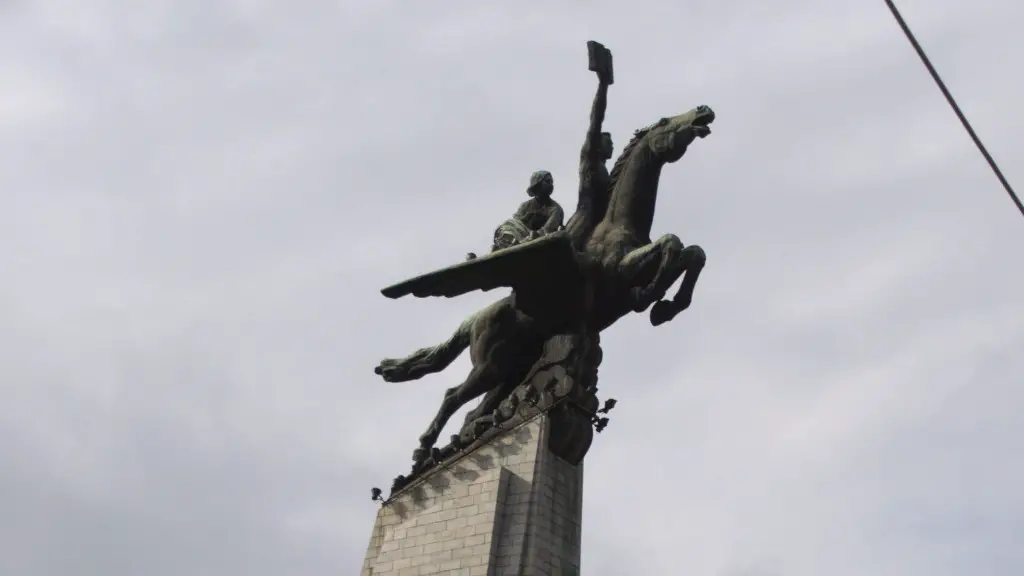Historical Background
The Korean Peninsula has been divided for nearly seventy-five years due to rivalries between the two nations. The country remained divided after the Japanese empire relinquished control of Korea at the end of World War II in 1945. In the aftermath of the war, Soviet Union troops occupied the northern half of the peninsula while U.S troops occupied the south. These two zones eventually consolidated into two separate nations – the Republic of Korea (South Korea) and the Democratic People’s Republic of Korea (North Korea). The transition was formalised in 1948 and the Cold War between the Communist and Democratic powers quickly had an influence on the Korean Peninsula.
The Unification Efforts
The Korean War, which occurred from 1950-1953, was the result of multiple conflicting interests from the superpowers that had become embroiled in Korean politics. The Korean War resulted in the temporary reunification of the peninsula, under the control of the North Korean leadership. However, the attempt to reunify was short-lived and failed to provide a lasting solution to the divided Korea.
Since the end of the Korean War, there have been a number of attempts to reunify the peninsula. In 1972, the North and South Korean leaders met for the first time in the North Korean capital of Pyongyang in the hopes of establishing permanent peace. However, the negotiations ended with no agreement reached and the peninsula remained divided.
In 2000, South Korean President Kim Dae-jung and North Korean leader Kim Jong-il met in the North’s capital city of Pyongyang in what became known as the June 15 Joint Declaration. This agreement promised to move towards “lasting peace and common prosperity” between the two nations. However, the two sides failed to reach a permanent unification agreement and there has been little success in further talks or negotiations.
International Involvement
Alongside the attempts to unify the Koreas, there have been multiple international attempts to de-escalate tensions between the North and South. Since 1953, the U.S. and China have proposed several peace plans, often involving both Korean leaders.
The United Nations Peacekeeping Command (UNC) has also played a role in attempting to maintain peace on the Korean Peninsula since its establishment in 1994. The UNC has monitored the demilitarised zone (DMZ) between the North and South and its mission includes “hotline” installations connecting the North and South, providing a direct line of communication.
Current Situation
Despite the multiple negotiations and attempts to reunify Korea over the years, the peninsula is still divided.
The horrific conditions of the North Korean regime have continued to worsen, deep entrenching the two nations and creating deep distrust between the two governments. The lack of communication has ensured the two countries remain distant. The South’s booming economy, the North’s extreme poverty and the level of human rights abuses in the North are all large obstacles to the reunification efforts.
The international community has not been able to come to a resolution on the Korean interaction, though various international policies have been effective in preventing tensions from escalating into conflict.
Geopolitical Implications
Korea’s division has had a large impact on the nation’s geopolitical standing. The North and South have had very different diplomatic approaches over the years, resulting in the two nations becoming allies with different countries. South Korea has strong diplomatic and economic ties with the United States, while North Korea has close ties with China. This relationship has further hampered unification efforts.
The Korean peninsula’s continued division has also had an impact on the nation’s defence capabilities. South Korea has a well equipped military, funded by the U.S, while North Korea maintains a large military presence in an effort to maintain control. This has resulted in a complex security and defence situation, with both sides worrying of an attack or an escalation into a conflict and has ultimately resulted in an arms race between the two sides.
Reunification Prospects
The need for Korean unity is becoming more important. The conditions in North Korea have led to many citizens fleeing the country and seeking refuge in South Korea. This has resulted in a number of social and economic issues for both the North and South.
The South Korean government has been working to build trust through various humanitarian aid and economic exchange programs. Additionally, the South Korean Prime Minister, Moon Jae-in, has strongly advocated for reunification and initiated the “Korean Unification Plan” in 2017.
The initiative showed promise, with a number of meetings held between the North and South, as well as with the United States and China. However, it seems that reunification efforts are still not close to being realized in the foreseeable future.
Economic Implications
The economic effects of the division, particularly for South Korea, have been profound. With the North’s continued isolationism and lack of resources, the South has been forced to develop its own economy without the North’s resource base. Reunification would benefit the South economically, as it would provide access to North Korea’s resources and allow the South to expand into new markets. It would also provide South Korean companies with access to the cheap North Korean labour force, which could significantly reduce production costs.
The consequences of the North and South Korean division have been far-reaching, with the effect being felt on every aspect of life including politics, economics, security, and defence. While there have been a number of attempts to reunify the peninsula, the reality is that there are numerous obstacles preventing lasting peace and a unified Korea.
Impact of Global Politics
The number of geopolitical events involving the two Koreas in the last few decades has only added to the complexity of the situation. As the U.S.-China relationship has become increasingly strained in recent years, both countries have sought to align themselves with either North or South Korea as a means of bolstering their own international standing. This has only served to further entrench the peninsula’s division, making it more difficult to make progress on the issue.
At the same time, the arrival of U.S. President Joe Biden has been seen as a potential breakthrough for Korean relations. Biden has emphasised the need for diplomacy and the importance of a peaceful solution to the Korean issue, signalling a move away from President Trump’s confrontational stance.
However, while there is room for optimism, it is important to remember that the two sides have been entrenched in their positions for a long time, making it difficult to bridge the gap.
Cultural and Language Differences
The cultural and linguistic differences between North and South have also been a major obstacle to Korean unification. Despite Korean being the official language of both nations, there are some noticeable differences between the North and South Korean dialects. These differences have resulted in communication and understanding becoming increasingly difficult over time, as North Koreans have become unfamiliar with South Korean culture.
Additionally, North Koreans are known for their loyalty to the government and its authoritarian ideology, which has created the illusion of reunification being impossible. Despite surface-level conversations about the potential for reunification, the two sides remain separated by both language and ideology.
Geographical Divide
The excessive militarisation of the DMZ has severely limited the people-to-people contacts between the two Koreas. The South is also increasingly distancing itself from the North’s influence as its development accelerates, creating further obstacles to unification. For example, the South currently maintains a ban on visits to the North, making it difficult for citizens of the South to engage in person-to-person interaction.
As the border becomes increasingly fortified, the cultures of the two sides become more divergent, creating a further divide that must be bridged in order for reunification to be possible.
The Role of International Powers
The role of international powers has been integral in shaping the situation on the Korean Peninsula. The U.S., China, and Japan have all played a role in negotiations and talks between the two nations, effectively preventing the situation from turning into open conflict. Their presence has also served to offer an alternative to military action, instead advocating for diplomatic solutions.
However, despite ongoing efforts from the international community, the Korean peninsula remains divided. The international community has largely championed diplomatic solutions, but the presence of the U.S. in the South and China in the North has only served to entrench the divisions, making a resolution more difficult than ever.


